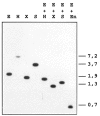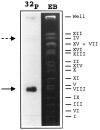RPC10 encodes a new mini subunit shared by yeast nuclear RNA polymerases
- PMID: 1617300
- PMCID: PMC6057363
RPC10 encodes a new mini subunit shared by yeast nuclear RNA polymerases
Abstract
Yeast RNA polymerases A, B, and C share five small subunits, two of which, ABC10 alpha and ABC10 beta, comigrate on SDS polyacrylamide gels. The gene encoding ABC10 alpha, RPC10, was isolated based on microsequence data. RPC10 is a single copy gene localized on chromosome VIII. It codes for a very basic protein of only 70 amino acids, which contains a zinc binding domain of the form CX2CX13CX2C. Deletion of its gene indicated that, despite its very small size, the ABC10 alpha subunit is essential for yeast cell viability. ABC10 alpha and ABC10 beta have little sequence similarity.
Figures




References
MeSH terms
Substances
LinkOut - more resources
Full Text Sources
Molecular Biology Databases
